The digital age has been pretty good to the films of Pete Walker. For a long period, the output of the British horror filmmaker was dismissed by genre fans as a footnote to the Hammer and Amicus films of the era, if they could even figure out what they were from the less-than-stellar VHS distribution and late-night television airings. Thanks to DVD releases from Shriek Show a few years back and the revived Redemption bringing Walker’s films to Blu-Ray, however, fans can now look at the works as pieces of a full filmography, and Walker’s name has since become well-known among the world of vintage exploitation. (The biggest exception being Walker’s final film to date, HOUSE OF LONG SHADOWS, which teams Vincent Price, Christopher Lee, Peter Cushing and John Carradine, as the film still languishes in Cannon’s archives.)
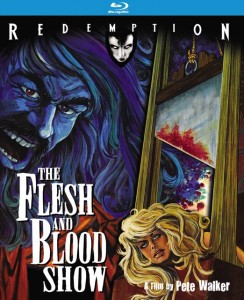 The most recent releases to have received the Blu-Ray treatment are 1972’s THE FLESH AND BLOOD SHOW and 1974’s FRIGHTMARE, and while the pair are only two years apart, the difference between the two in terms of genre familiarity seems much larger. Both, however, are worth a look, especially in a form that makes up for years of sub-par presentations and allows them to be seen with all of the garish colors and carefully-lit shadows that Walker and cinematographer Peter Jessop intended.
The most recent releases to have received the Blu-Ray treatment are 1972’s THE FLESH AND BLOOD SHOW and 1974’s FRIGHTMARE, and while the pair are only two years apart, the difference between the two in terms of genre familiarity seems much larger. Both, however, are worth a look, especially in a form that makes up for years of sub-par presentations and allows them to be seen with all of the garish colors and carefully-lit shadows that Walker and cinematographer Peter Jessop intended.
THE FLESH AND BLOOD SHOW is occasionally cited as a pro-slasher film, and it certainly has the set-up to be one — A group of young actors are hired to put together an improv play at a closed theater in a seaside town in order to re-open the place and end up stalked by an unseen killer. It sounds an awful lot like a would-be predecessor to Michele Soavi’s STAGEFRIGHT or Jean Pellerin’s A CLOWN AT MIDNIGHT.
The lineage isn’t that simple, however, as THE FLESH AND BLOOD SHOW doesn’t really feel like a slasher movie at all until the climactic final reel. The actors spend a fair time working on their show, which, from what I can see, looks insufferable, like a version of “Oh, Calcutta” with no nudity. They pair up into groups, they leave the theater for a while, and they talk quite a bit. Despite some well-directed moments and solid stalking sequences, you never really get the sense of isolation that would seem prerequisite for a slasher film – it always seems too simple for the cast to just, well, leave, and the body and gore count never reaches the point that would seem out of place at the time. TWITCH OF THE DEATH NERVE this ain’t.
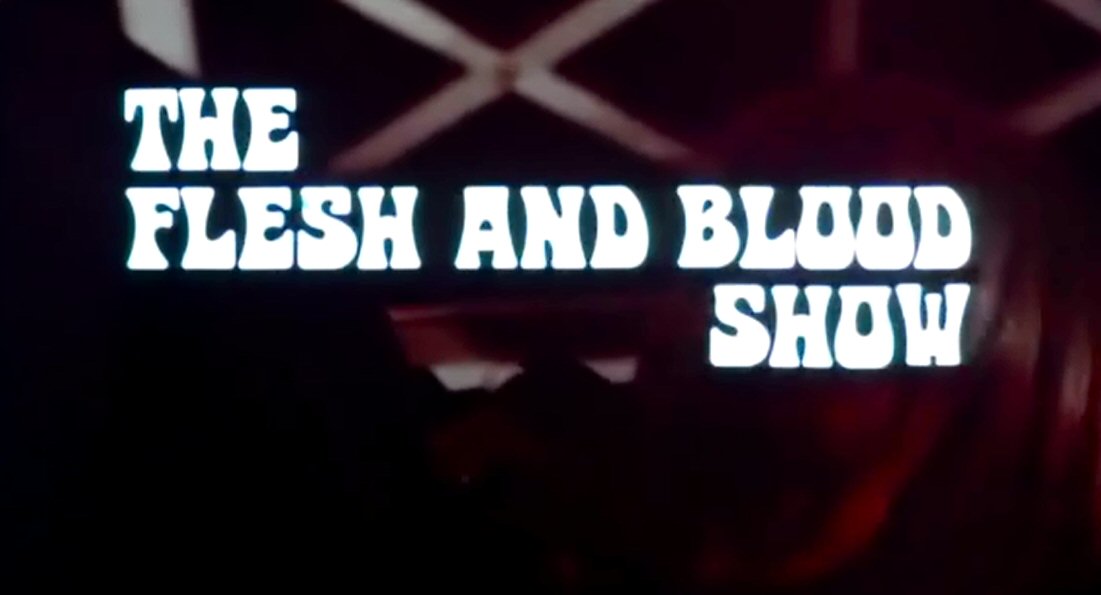
The emphasis is on flesh rather than blood for much of the film, and it’s not too surprising, as Walker had come from a sexploitation film background. All of the young actresses don’t have a problem baring all, even if it make little sense, such as the opening scene when a young woman answers the door in the middle of the night without bothering to put on a stitch. Just to be fair, we do get some last-minute frontal male nudity as well, but for the most part, the amount of flesh on display isn’t far off from Walker’s previous film, the sex comedy FOUR DIMENSIONS OF GRETA.
Another thing FLESH AND BLOOD had in store with FOUR DIMENSIONS is that it originally jumped out at you from the screen in 3-D, though FLESH AND BLOOD saves its third dimension for the Othello-inspired climax. Presented in black and white in the feature itself, the Blu-ray gives you the option to watch the climax in 3-D in either stereoscopic or anaglyph formats for the first time since the film’s theatrical release.
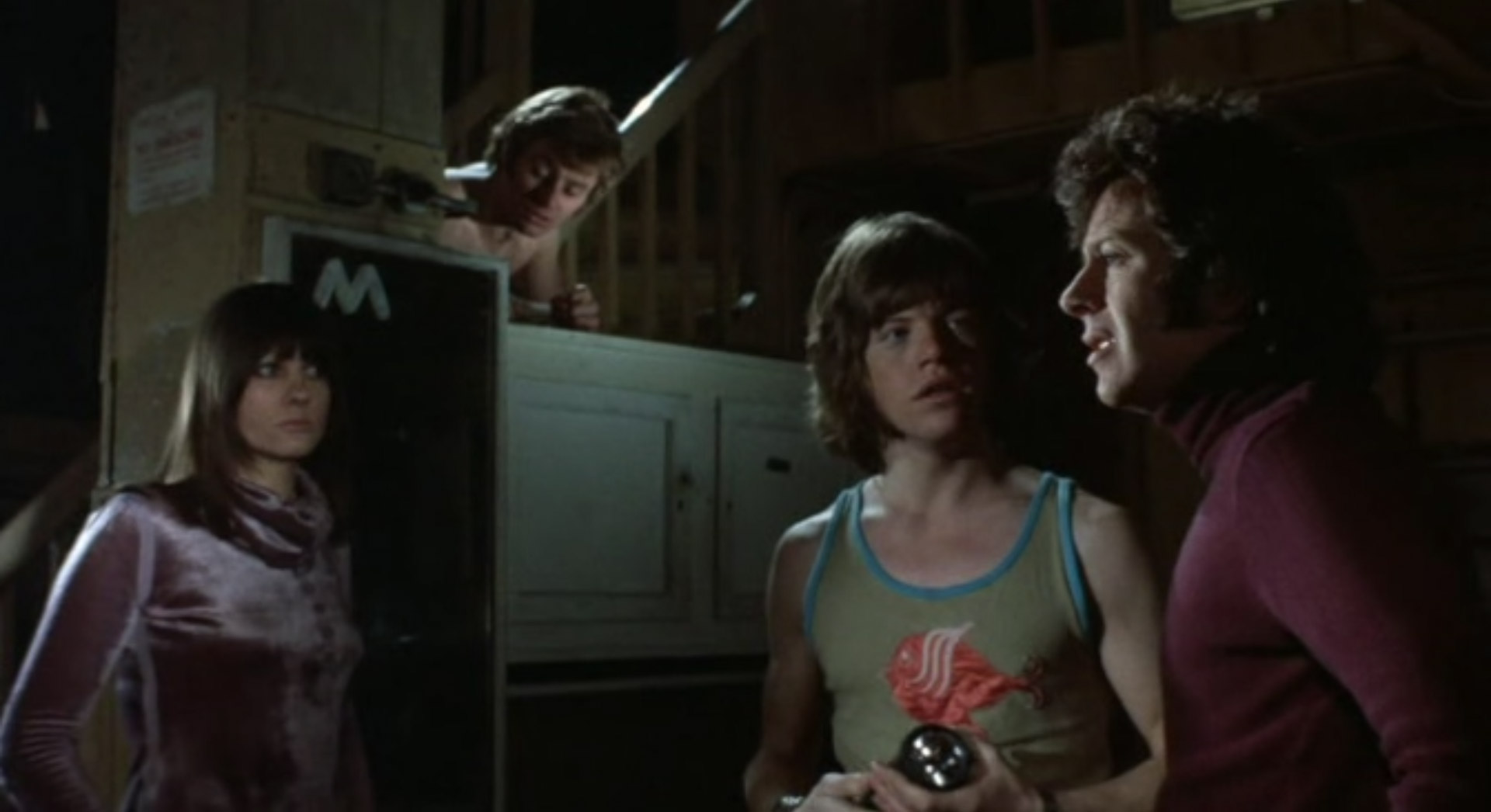
THE FLESH AND BLOOD SHOW certainly has its moments, and Walker takes some entertaining stabs at pretentious “art” film and theater, but for all of the talking the characters do, they’re not really given much depth and it’s sometimes difficult to differentiate between them. With the minimal bloodshed, it comes across as more like an adult-oriented “Scooby Doo” episode rather than a curious footnote in slasher film history, but it’s still worth a look for British horror fans.
Released on VHS and Beta by Wizard Video in packaging that sells the flesh more than the blood (in actuality, more accurate than the original poster art replicated on later releases), then again on VHS by Monterey utilizing the poster art, and later still by Something Weird. In 2006, Shriek Show released a solid version of the film on DVD, but Redemption has done an admirable job with the new release, bringing out the colors beautifully and including a solid interview with Walker conducted by AMERICAN GRINDHOUSE filmmaker Elijah Drenner.
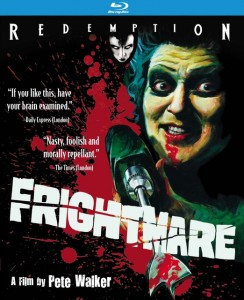 Those colors are even more vividly on display with Redemption’s new Blu-Ray of Walker’s FRIGHTMARE, a film that relishes its horror credentials with glee. From the black and white opening sequence to the deliciously sinister climax, FRIGHTMARE feels like Walker after he’d gotten his horror footing, and it’s a unique cannibal tale that sets itself apart from the other, dingier cannibal flicks that populated the later ’70s in the wake of THE TEXAS CHAIN SAW MASSACRE.
Those colors are even more vividly on display with Redemption’s new Blu-Ray of Walker’s FRIGHTMARE, a film that relishes its horror credentials with glee. From the black and white opening sequence to the deliciously sinister climax, FRIGHTMARE feels like Walker after he’d gotten his horror footing, and it’s a unique cannibal tale that sets itself apart from the other, dingier cannibal flicks that populated the later ’70s in the wake of THE TEXAS CHAIN SAW MASSACRE.
FRIGHTMARE tells the story of the Yates family, the parents of the clan having been recently released from a mental institution after mother Dorothy (an excellent Sheila Keith) consumed six people a couple of decades earlier. Apparently “cured,” she and her ridiculously devoted (and weak) husband Edmund (Rupert Davies) live in a small farmhouse as make-up artist Jackie (Deborah Fairfax), his older daughter from his first marriage, sees them when she can while taking care of her “15 year old” half-sister Debbie (Kim Butcher, who looks to have been pushing 30 at the time), a troublemaker who goes around picking fights with bartenders with her biker boyfriend
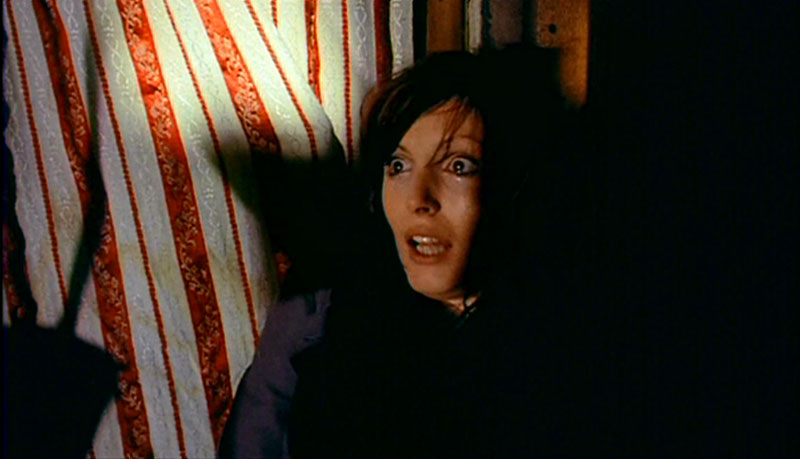
As it turns out, Dorothy isn’t cured at all. Becoming a tarot card reader and placing ads in “Time Out,” Dorothy is still luring people to their deaths, even as Jackie tries to placate her stepmother’s tendencies by offering her butcher-bought meat. Meanwhile, Jackie’s psychiatrist-in-training love interest sets out to investigate, and Debbie starts showing signs that the psychosis may very well be genetic. Pretty soon, there’s one big family reunion, and it’s not the kind they make a National Lampoon movie out of.
FRIGHTMARE is highly entertaining, with the prerequisite bloodshed in full force and characters that feel unique and fleshed-out, even if they’re not exactly realistic. At the heart of it all is Keith’s fantastic Dorothy, a grand dame of horror if there ever was one, and a character that ranges from quiet and soft-spoken to bloodthirsty and savage with ease. She’s so well-presented that she’s almost sympathetic – the idea that she’d advertise for tarot readings deliberately to attract lonely people makes her less a monster than a fascinatingly deranged nice old lady.

Redemption’s Blu-Ray shows off the film to excellent effect (especially when compared to the ancient VHS release, where it hit the United States under the title FRIGHT MARE II in order to avoid confusion with Norman Thaddeus Vane’s FRIGHTMARE, released nearly a decade later!), and as Jessop’s cinematography utilizes deep blacks instead of just shadow, it’s a revelation that improves upon Shriek Show’s earlier DVD release quite a bit. A commentary track with Walker and Jessop, conducted by author Steve Chinball (whose book on Walker, “Making Mischief,” is a great read) is ported from the Shriek Show release, and it’s a solid one, though there is a point about halfway in where the commentary repeats with a story about Anthony Sharpe’s reaction to Walker’s HOUSE OF MORTAL SIN. Walker is dismissive of any biographical subtext when it’s brought up that he, like one of the lead characters, had an absent mother and grew up in an orphanage, and contends that psychiatry is a waste of time.
A similar attitude is evident in “For the Sake of Cannibalism,” a new interview with Walker conducted, again, by Elijah Drenner, as the director shrugs offs assertions that his films mean anything – and then remarks about how it may be a commentary about the “liberal” ideas on curing the criminally insane! The film, in fact, works as well as an indictment against an lackluster mental health, so everybody wins.
The disc is rounded out by trailers for other films in the Walker library, stills, and a short documentary on the late Keith, whose only horror credits were those in Walker films, along with her final role in the Walker-influenced “Dr. Terrible’s House of Horrible” television series. It’s a fitting tribute to an underrated actress, and one whose abilities move FRIGHTMARE from a solid little horror film to a genuinely entertaining one.
Both films are certainly worth a look for horror fans, but FRIGHTMARE’s presentation and the fact that the film feels more polished gives it the edge over FLESH AND BLOOD. In any case, it’s great to see these films on Blu-Ray, and we’ll be eagerly waiting for the next batch of releases Redemption brings to the new format.
@Paul Freitag-Fey
- [THE BIG QUESTION] WHAT’S YOUR FAVORITE FEMALE ENSEMBLE IN MOVIES? - July 22, 2016
- [IN THEATERS NOW] THE BOY (2016) - January 24, 2016
- Cult Movie Mania Releases Lucio Fulci Limited Edition VHS Sets - January 5, 2016






No Comments